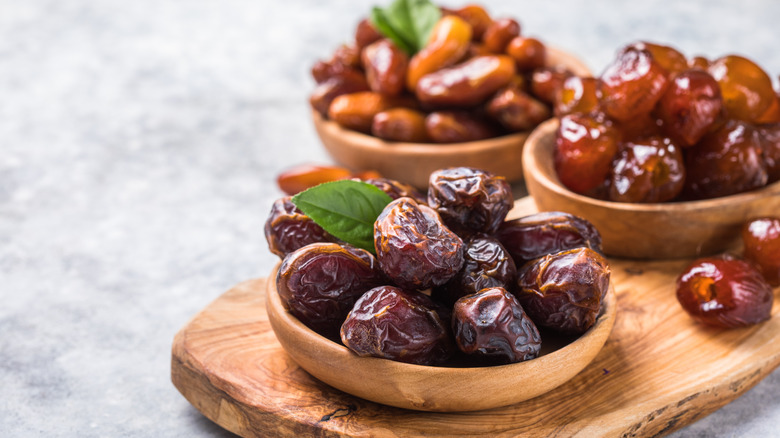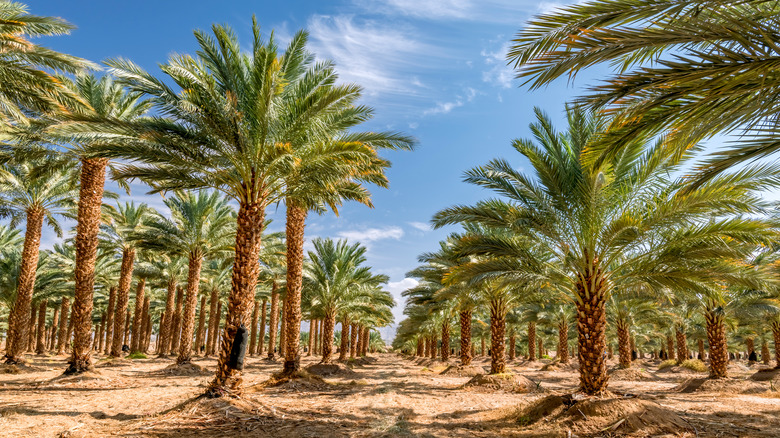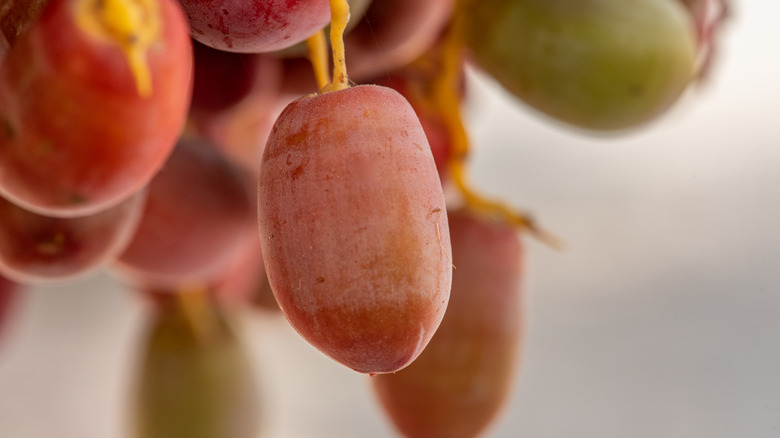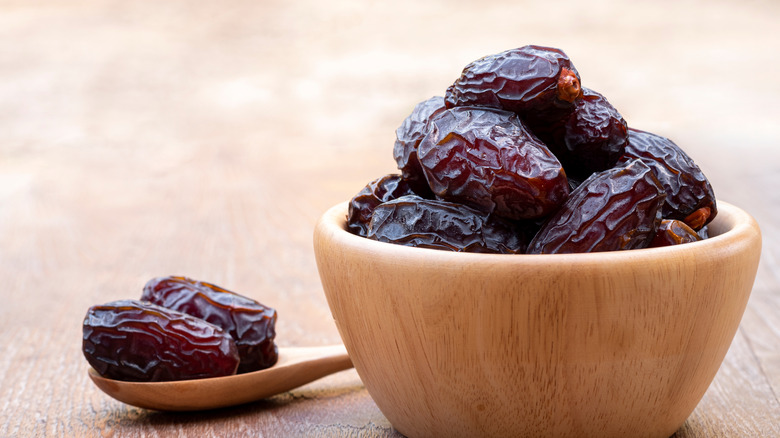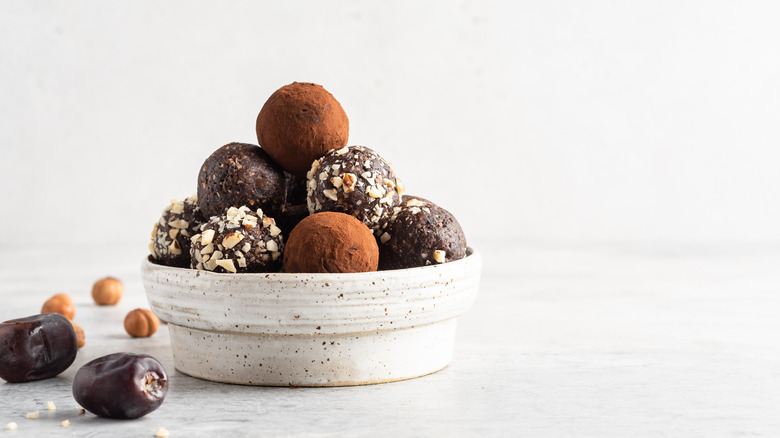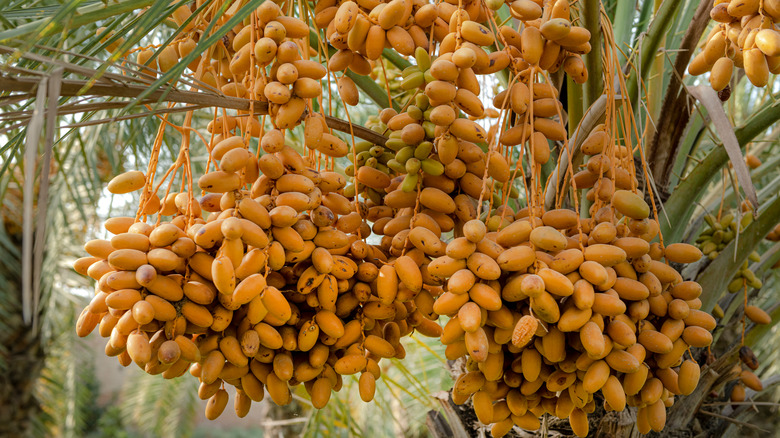What Are Dates And How Do You Eat Them?
Sometimes stuffed with cheese and wrapped in bacon, oftentimes added to salads, occasionally blended into smoothies or protein shakes, and perhaps even dotting charcuterie boards, dates are a relatively common component that rarely stands on its own. Their candy-like, saccharine notes and subtle chewiness can add incredible complexity and flavor to anything they are added to, but what exactly are they? How many different variations are there?
If you guessed "a fruit," then good news, you're correct! It is actually grown on the date palm tree, which is native to Northern Africa and the Middle East, according to Delighted Cooking, while Foodprint notes that evidence of dates has been linked to the Neolithic period. The date palm was considered the "tree of life" for many civilizations because "every aspect of the plant" can be utilized in some capacity. The scientific name of the tree (phoenix dactylifera) is actually said to be in reference to the phoenix, a nod to the date palm tree's resilience in scorching desert temperatures.
History of dates
Harvesting fruit from the date palm tree is a protracted process that begins with hand-pollination by agricultural workers. Each palm must be trimmed and carefully monitored. Thus, harvesting can take anywhere from seven to 10 years. Real Simple notes that dates have been eaten for over 6,000 years. According to Food and Nutrition, dates were said to be originally grown throughout Egypt and Mesopotamia in 4,000 BC. The Bedouin, a nomadic tribe, cherished the date centuries ago due to their long shelf-life and their ability to travel well, according to FoodPrint. Dates came to the U.S. just before 1900. An agricultural explorer named Walter Swingle is said to have brought the Medjool date to the U.S. from a Moroccan oasis, which all current Medjools can be traced to.
Now, dates are cultivated in California, Florida, and Arizona, but the majority are still grown in the Middle East and North Africa.
What do dates taste like?
Dates grow in clusters that hang under the leaves of the date palm tree. The flavor is intensely sweet, redolent of natural sugars, and the dried or preserved date's sweetness is even more intensified due to the concentration of flavor post-dehydration. Be mindful, though, to get rid of the seed before eating with gusto — all dates have one long, large seed under the flesh (via FoodPrint).
While dates can be eaten fresh, many are used to the dried variety, which can be purchased year-round. However, if you're lucky enough to stumble upon fresh dates — we implore you to buy them. Biting into a fresh date can be a truly formative culinary experience. Dates are exceptionally sweet, while Epicurious notes that some varieties can even be called syrupy or buttery. SF Gate notes that their texture is creamy and their flavor can even be comparable to caramel.
Varieties of dates
One of the most common varieties of dates is the Medjool — which many recipes call for — but there are a variety of other types (via FoodPrint), including Black Sphinx and Deglet Noor. Taste of Home notes that Medjool dates are larger and slightly darker, while Deglet Noor dates are smaller and drier.
Harvest to Table says that dates are best from autumn to winter, and to be super careful when cutting dates or removing pits because the residue can be sticky on the knife and make cutting or slicing challenging. In addition to the aforementioned varieties, others include Barhi, Dayri, Halawy, Thoory, and Zahidi. Each has subtle differences which help to differentiate from the other types. Homeperch actually notes that there are more than 25 varieties of dates grown and sold worldwide.
According to Leafy Place, dates can be divided into 3 categories: soft, semi-dry, or dry. It can be tricky: There's such a thing as a "dry variety of a fresh date," which is a very item than a dried date, which has been almost fully dehydrated and has a longer shelf life. It can definitely get a little complicated to keep track of all the different types.
How do you cook with dates?
Dates can also be used to thicken or sweeten milkshakes, smoothies, or even baked goods. Of course, they're also fine to snack on as is. Date sugar is also a great alternative for other sugars. MasterClass notes that dates are also used in Middle Eastern date cookies, date and nut breads, and even stirred into savory dishes like tagines. Of course, the pit is removed first. They're also wonderful in raw fruit or vegetable slaws and salads, adding a pop of bright, sweet flavor and chewiness.
In addition to the aforementioned dishes and recipes, dates are also an incredibly common inclusion in 'natural' energy or protein bars or truffles, often incorporating the sticky-sweet fruit in the place of artificial sugars, sweeteners, or chemicals. Furthermore, they're often mixed into certain cakes, pies, or other baked goods, adding both texture and flavor. When incorporating dates into your cooking, there might be a subtle variation in the flavor profiles depending on which variety you use, which is always a welcome surprise.
Nutritional information about dates
In addition to their marvelous flavor, dates are an absolute treasure trove of nutritional and health benefits. They contain potassium, magnesium, copper, manganese, iron, and vitamin B6, according to Healthline, and they're also high in fiber. They are packed in antioxidants like flavonoids, carotenoids, and phenolic acid, with the possible potential to promote brain health. They also provide a natural source of sweetener without artificial sugars or even honey or agave.
Believe it or not, dates are also very beneficial for pregnant people, in that they may help facilitate contractions and promote natural labor, according to Healthline. Taste of Home notes that they also provide energy, promote healthy digestion, reduce cholesterol, and mitigate inflammation.
BBC Good Food reports that dates can cause allergic reactions in some people, so definitely be sure to be careful if you're unacquainted with dates and trying them for the first time. Furthermore, BBC notes that dates that clearly have crystallized sugar on them are typically a sign that they're not ideal from a freshness perspective.
